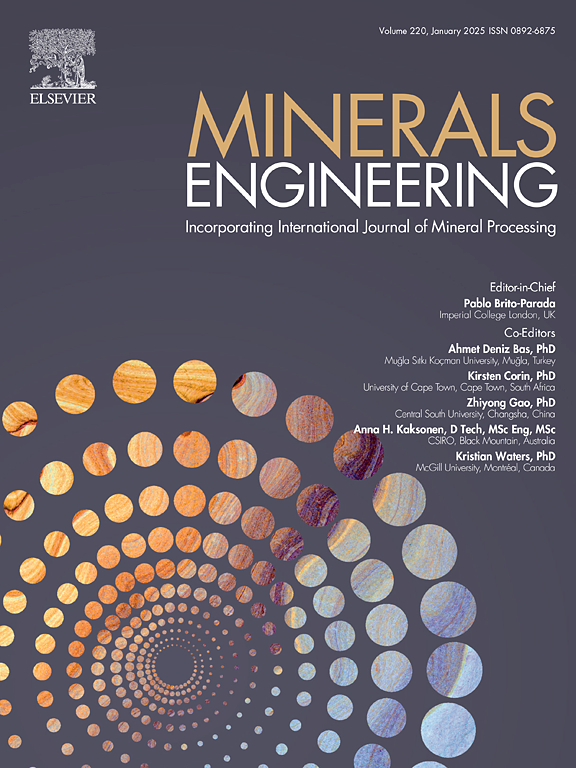铁取代对闪锌矿配位性能的影响
IF 5
2区 工程技术
Q1 ENGINEERING, CHEMICAL
引用次数: 0
摘要
在自然界中,当Fe含量大于6%时,是闪锌矿晶格中最稳定的杂质。Fe以同构形式溶解于矿物晶格中,即取代Zn形成含铁闪锌矿,其化学式为[ZnxFe(1-x)] S,属于等长晶体体系,具有离子共价键,形成能负最多,比元素掺杂ZnS矿更稳定。不同Fe含量的闪锌矿性质差异较大。闪锌矿与铁的配位本质上是电偶效应。不同铁含量的闪锌矿表面晶体结构发生变化,导致Fe- zns电子重排。s位点的缺陷改变了配体的排列,导致在与Fe相互作用时形成Fe- s键。这导致了闪锌矿的表面配位行为和晶格间距的改变。在四面体场的作用下,e轨道是π轨道,t2轨道既是σ轨道又是π轨道。由于Fe2+有一对π电子,所以含铁闪锌矿的反应性提高。这一发现为天然铁闪锌矿作为矿物材料提供了理论依据。本文章由计算机程序翻译,如有差异,请以英文原文为准。
Effect of iron substitution on the coordination properties of sphalerite
In nature, when the Fe content is greater than 6 %, it is the most stable impurity in the sphalerite lattice. Fe dissolves in the mineral lattice in an isomorphous form, that is, it replaces Zn to form Fe-containing sphalerite, whose chemical formula is [ZnxFe(1-x)] S, which belongs to the isometric crystal system, has ionic-covalent chemical bonds, has the most negative formation energy, and is more stable than element-doped ZnS ore. The properties of sphalerite with different Fe contents vary greatly. In essence, the coordination between sphalerite and Fe is a galvanic effect. The surface crystal structure of sphalerite with different Fe contents changes, resulting in Fe-ZnS electron rearrangement. The defect at the S-site alters the ligand arrangement, leading to the formation of Fe-S bonds as it interacts with Fe. This results in modifications to the surface coordination behavior and the lattice spacing of sphalerite. Under the action of the tetrahedral field, the e orbital is a π orbital, and t2 is both a σ orbital and a π orbital. Since Fe2+ has a pair of π electrons, the reactivity of Fe-containing sphalerite is increased. This discovery provides a theoretical basis for natural iron sphalerite as a mineral material.
求助全文
通过发布文献求助,成功后即可免费获取论文全文。
去求助
来源期刊

Minerals Engineering
工程技术-工程:化工
CiteScore
8.70
自引率
18.80%
发文量
519
审稿时长
81 days
期刊介绍:
The purpose of the journal is to provide for the rapid publication of topical papers featuring the latest developments in the allied fields of mineral processing and extractive metallurgy. Its wide ranging coverage of research and practical (operating) topics includes physical separation methods, such as comminution, flotation concentration and dewatering, chemical methods such as bio-, hydro-, and electro-metallurgy, analytical techniques, process control, simulation and instrumentation, and mineralogical aspects of processing. Environmental issues, particularly those pertaining to sustainable development, will also be strongly covered.
 求助内容:
求助内容: 应助结果提醒方式:
应助结果提醒方式:


